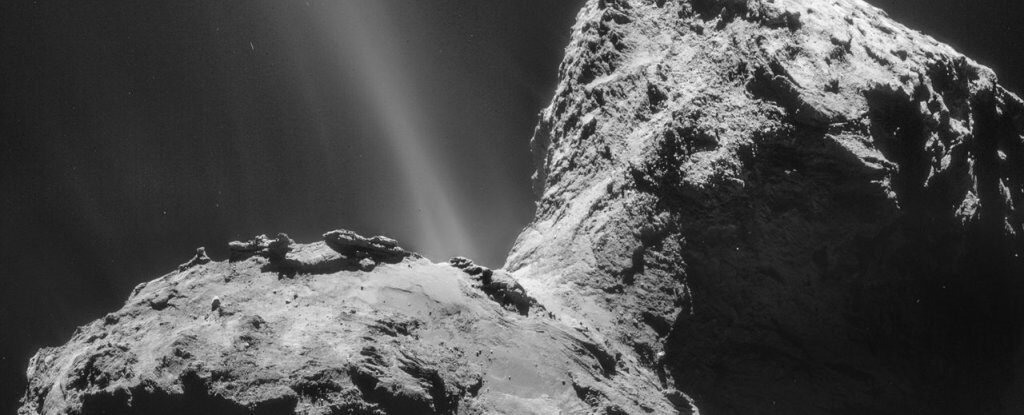
© ESA/Rosetta/NAVCAMComet 67P/Churyumov-Gerasimenko.
Aurora - the dancing glow of ionised particles in Earth's upper atmosphere - is not unique to our planet.
The phenomenon has been spotted shining in the atmospheres of every other planet except Mercury. Even Jupiter's moons Ganymede and Europa have auroras.
Never, until now, had an aurora been detected on a comet.But, in a new analysis of data collected by the
Rosetta spacecraft, the space around Comet 67P Churyumov-Gerasimenko (67P/C-G)
has been observed glowing with far-ultraviolet auroral radiation."I've been studying the Earth's auroras for five decades,"
said physicist Jim Burch of the Southwest Research Institute.
"Finding auroras around 67P, which lacks a magnetic field, is surprising and fascinating."Auroras are generated by the excitation of charged particles in an atmosphere.
Here on Earth, for instance, the solar wind blows into the magnetosphere and interacts with charged particles there.
These particles rain down into the upper atmosphere and are funneled up the magnetic field lines to the poles, where they manifest as rippling curtains of light.
It works differently on different bodies, though. The auroras of
Ganymede and
Europa are generated by interactions with Jupiter's magnetic field.
Venus doesn't have a magnetic field of its own that we know of, but interactions with the solar wind creates one strong enough to trigger auroras.
Mars' atmosphere is extremely thin, but its weak magnetic field can support auroras.
Jupiter's permanent aurora isn't caused by the solar wind, but some
mysterious mechanism yet to be discovered.
And while Saturn's main auroral ring seems to be solar wind-generated, there are patches of it that... are unpredicted.
That's also still a mystery.
Comet 67P/C-G doesn't even have a borrowed magnetic field. But it does have an atmosphere, of sorts - the envelope of gas called a coma that surrounds the nucleus of an active comet when it draws close enough to the Sun for ices trapped therein to sublimate.
It was in this coma that the far-ultraviolet (FUV) spectrograph on the Alice instrument aboard the
Rosetta spacecraft detected a glow in far ultraviolet light.
Alice's Ion and Electron Sensor (IES)
detected an even bigger surprise - electrons from the solar wind."Initially, we thought the ultraviolet emissions at comet 67P were phenomena known as 'dayglow,' a process caused by solar photons interacting with cometary gas,"
said astronomer Joel Parker of the Southwest Research Institute.
"We were amazed to discover that the UV emissions are aurora, driven not by photons, but by electrons in the solar wind that break apart water and other molecules in the coma and have been accelerated in the comet's nearby environment. The resulting excited atoms make this distinctive light."
The team simulated a weakly outgassing comet, and found that interplanetary magnetic field lines draped around the comet are sufficient to provide a path to accelerate solar wind electrons into a potential well created by an electric field around the cometary nucleus, produced by the cometary plasma.
However, because the comet has no magnetic field of its own, the aurora itself is diffuse, in contrast to contained auroras generated by solar wind excitation on Earth and Mars.
The combination of the acceleration process and the excitation process make Comet 67P/C-G's aurora unique so far in the Solar System, the researchers said.
The discovery could offer new clues to understanding how auroras are generated throughout the Solar System.
But cometary auroras can be used as a tool for understanding space weather. By probing the glow at various distances from the Sun, astronomers could learn a lot about electron variability in the solar wind.
Could comets get any more awesome?
The research has been published in
Nature Astronomy.
Reader Comments
It used to in my country, but we voted leave..
(Sad times)
R.C.